|
What do you do after you've overthrown everyone's
notions of art back to the Parthenon, impugned
Western Civilization, and caused assassinations
and revolutions? Or are alleged to have done so,
greatly to your sales advantage if not your artistic
reputation?
Andy Warhol, or at least his reputation, faced this
question in the later years of his life. After you've
shaken everything by bringing a sculpture of a box
of Brillo, identical visually to its models, into a
high-art gallery and said, "This is Art", and
made it stick, you probably can't just bring another
box of Brillo in next week and next year and so on.
The first box was the one with the Pow!
Further Brillo boxes would soon become a standing,
rather corny joke. "Okay, Brillo, we get it, Andy,"
bored cognoscenti would soon be murmuring.
Before long Warhol said he had given up painting (another
put-on.) He was going to make movies and
photograph-based society portraits.
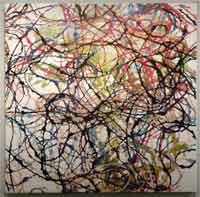
|
|
Fibers
|
Actually, Warhol never stopped painting, and never
stopped being artistically authentic and "original"
in spite of all the put-ons and put-downs. The world,
however, had changed; he was one of those who had
changed it. And so asked to do an illustration for a
fabric manufacturer, he tangled up a lot of wool, took
a picture, silkscreened it, and turned out something
that had the looks, even the rhythm, of one of Jackson
Pollock's better pieces.
At one time, a trick like that would have made a
stir in the art world. But by the time it was
shown, although it might be great art, it could no
longer shock anyone. The bourgeoisie still wanted
to be properly epatéed and they
weren't going to get it from a Pollock knock-off,
however clever. But it's art -- the
art part of art, rather than the commerce,
the social standing, the celebrity, the
mystification. And besides being an enfant terrible,
a "holy terror", and the scourge of Western
Civilization, Warhol was also a "real" artist, and
one interested in such things has some reason to go
to the show at the Brooklyn Museum. What they
will see is always interesting and sometimes
moving.
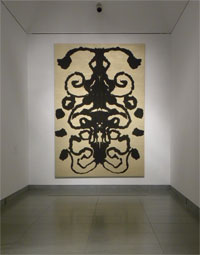
|
|
"Rorschach"
|
This is is not to say that the Old Warhol is completely
missing. Not abandoning the Duchampian ethos
completely, and in fact referring rather pointedly
back to the works of "R. Mutt", Warhol and his
friends pissed on a collection of pure copper plates
and pigments which then turned into various shades
of splashy green and blue the way copper does when
it's exposed to something exciting. A little further
down the aleatic road, Warhol and company made some
rather imposing
"Rorschachs"
-- those staples of
1950s pop psychology and innumerable jokes of the era
("I don't know, Doc -- you're the one with the dirty
pictures!") These Rorschachs are several feet high
and wide and tend to dominate whatever space they're
in with their mysterious, symmetrical, abstract forms.
Pictures of Warhol making the paintings assure us that
they were pretty random, just the folded paper with
an ink blot in the middle, but on a very large scale.
There are quite a few 'camouflage' paintings
which are another excursion into total, seemingly
free-form abstraction, and yet they are obviously
quite carefully done in military style, presaging
the military theater of our own era.
There are also a number of large blow-ups of very
small parts of photographs of ordinary objects which,
because of the degree of magnification and severity
of the cropping, look like pure abstract art (and
in most cases, even when we know what they are,
do not yield represented objects to the viewer.)
Most photographers have manipulated their prints
to some extent, whether in the developing pan and
the enlarger or more recently in their computers;
these paintings represent that bag of tricks being
taken to its natural limit and placed on a very large
scale, with results that would delight the Abstract
Expressionists, or at least make them very jealous.
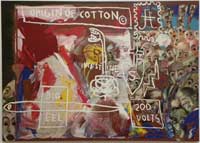
|
|
"Warhol/Clemente/Basquiat: The Origin of Cotton"
|
Besides the move toward Ab-Ex and minimalism, Warhol
also explored the world of graffiti: there is are a
series of collaborations with Basquiat and others.
These tend to be large playful monsters and they
look mostly Basquiatish rather than Warholian to me.
Typically Warhol would screen something and then let
Basquiat work out over the screen print. However,
Warhol later said that Basquiat had gotten him
interested in painting again, so he must have picked
up a brush or two during the process.
One aspect of the late works is the appearance
of religious images and motifs. Warhol was always
interested in the most popular images and it is
not remarkable that he chose cheap reproductions of
Da Vinci's "Last Supper" to work from, particularly
the image of Jesus which is at its center, which
he drew or traced in elementary outline form from a
reproduction and then used repeatedly. The Da Vinci
painting shows the moment when Jesus reveals to his
apostles that he will be betrayed by one of them;
while the apostles recoil in confusion, Jesus himself
looks down and a bit to the side, apparently resigned
to his fate. This image is used over and over again
in a surprising variety of contexts.

|
|
Christ 112 Times
|
:
One of the more striking examples of his religious
work is "Christ 112 Times", Christ being the detail of
Da Vinci's 'Last Supper' mentioned above in a golden
yellowish orange on a black or very dark background.
Each of the Christ-images is about 20 inches high
by 16 inches wide, and they are arranged in a grid 4
images high and 28 wide, so the size of the overall
painting is 6 2/3 feet high and 35 feet wide.
The museum displays this gigantic painting to
great advantage in a large room on the 5th floor,
so arranged that as you walk towards the room and
enter it, it is as if curtains were pulled back
dramatically to the side and the whole is suddenly
revealed in all its power. Next to it is a more
conventional series of copies of the Last Supper; the
image of the black-and-white reproduction is doubled
and painted over a brilliant pink or yellow ground;
the color modifies and further distances the
reproduction of the reproduction from the viewer.
It is tempting to treat Pop Art as almost
entirely ironical, regardless of the talk about
love of beer cans and gas stations in the sunset
glow. However, it is doubtful whether Warhol's
religious paintings can be fully understood in
this light. In spite of all the sex, drugs and
rock'n'roll going on around him, Warhol was an
observant Byzantine Catholic, a frequent
churchgoer, as had been his Rusyn parents. Having
come face to face with violent death, he may well
have had his mind on eternal things throughout the
later period of his life.
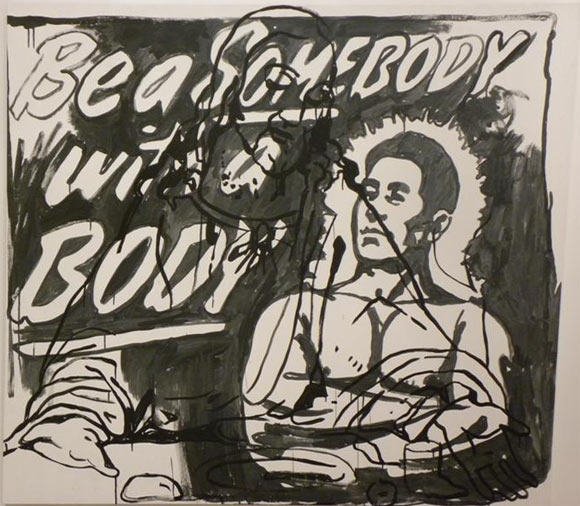
In spite of all this, an ironic -- maybe doubly
ironic -- note can be found in some of the religious
works. In one case Christ-images repeatedly overlay
motorcycles, corporate logos, and what looks like
supermarket advertising. Does this mean Jesus is
just another product? In another installation (not at
this show, but in the catalog) there is a sequence of
punching bags designed along with Basquiat, each with
the same image of Christ on it. Most strikingly,
an advertisement for a cheap home-study course in
boxing showing a crouching boxer is overlaid with
the Christ image; the latter comes through only after
one first sees the boxer. Part of the advertisement
is the slogan "BE SOMEBODY WITH A BODY." We have
not only the contrast between a young pugilistic man
eager to make his mark in the world and the resigned,
pacifistic Christ, who perhaps we are supposed to
punch or think of as a puncher with "A BODY" but we
are reminded as well that in the early centuries of
Christianity Roman Catholicism struggled with Arianism
and Gnosticism to establish a concept of Christ which
was at once fully divine and fully human, so that the
physical existence and sufferings of Jesus became a
primary aspect of the Church's teachings.
While Warhol was probably not a student of early
Church history (although you never know) he would
certainly have been reminded of the physicality of
Christ by his religious upbringing. Every time Warhol
went to mass, he would have heard the priest intone
'This is my body ...' during the ritual of
Communion. Therefore, presenting Christ superimposed
on a boxer, or on a boxer's punching bag, is a kind of
irony, but it is not lightly or dismissively ironic;
instead, the viewer finds that his own concept of
Christ or at least of the Christ-figure has been
profoundly challenged. If it is irony it is a
very deep sort of irony.
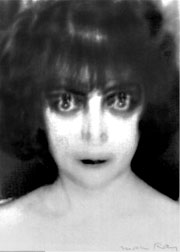
|
In the same room are some large paintings made
from one of Warhol's favorite self-portrait images,
one with a dire expression on his face and his wig
askew, some of the strands of hair standing straight
up in the air. Most striking among these is one in
which, over a violet ground, the image is doubled
by superimposing a positive and a negative screen of
the photograph on the canvas. One can't help but be
reminded of Man Ray's famous double image of Countess
Luisa Casati.
|
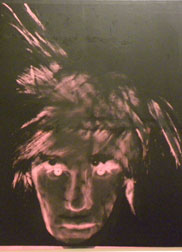
|
Besides these impressive paintings, the museum has
put up some Interview covers and is showing
some of Warhol's television programs in a roomful
of monitors. These are quite popular, but I think
they belong more to the celebrity-infested middle
period of Warhol's artistic evolution than to the
late paintings. There are also some revisitings of
works from an earlier period, like a 2 x 2 Black
Marilyn.
It's nice to see that the Brooklyn Museum has
rescued Warhol the great painter and designer from
the shadow of Warhol the Holy Terror and Warhol the
Pop metacelebrity. The latter may draw crowds
and make for best-sellers, but art-the-real-thing
belongs to the former.
|

